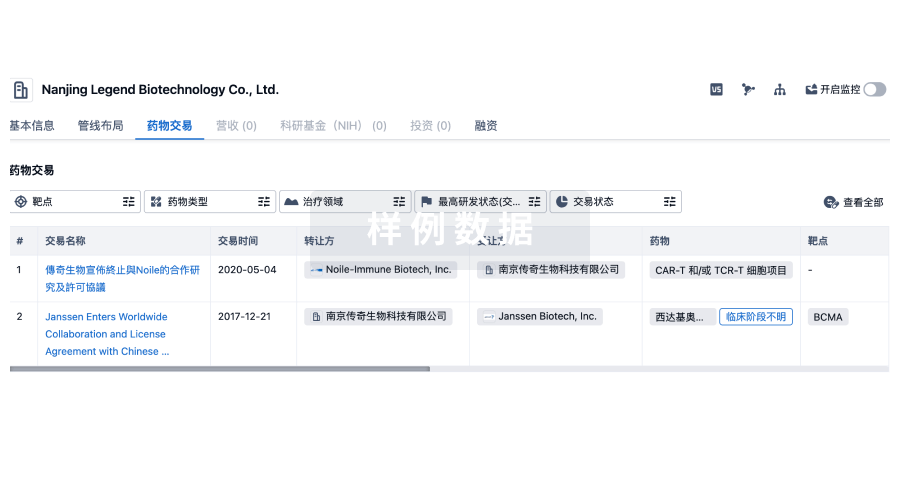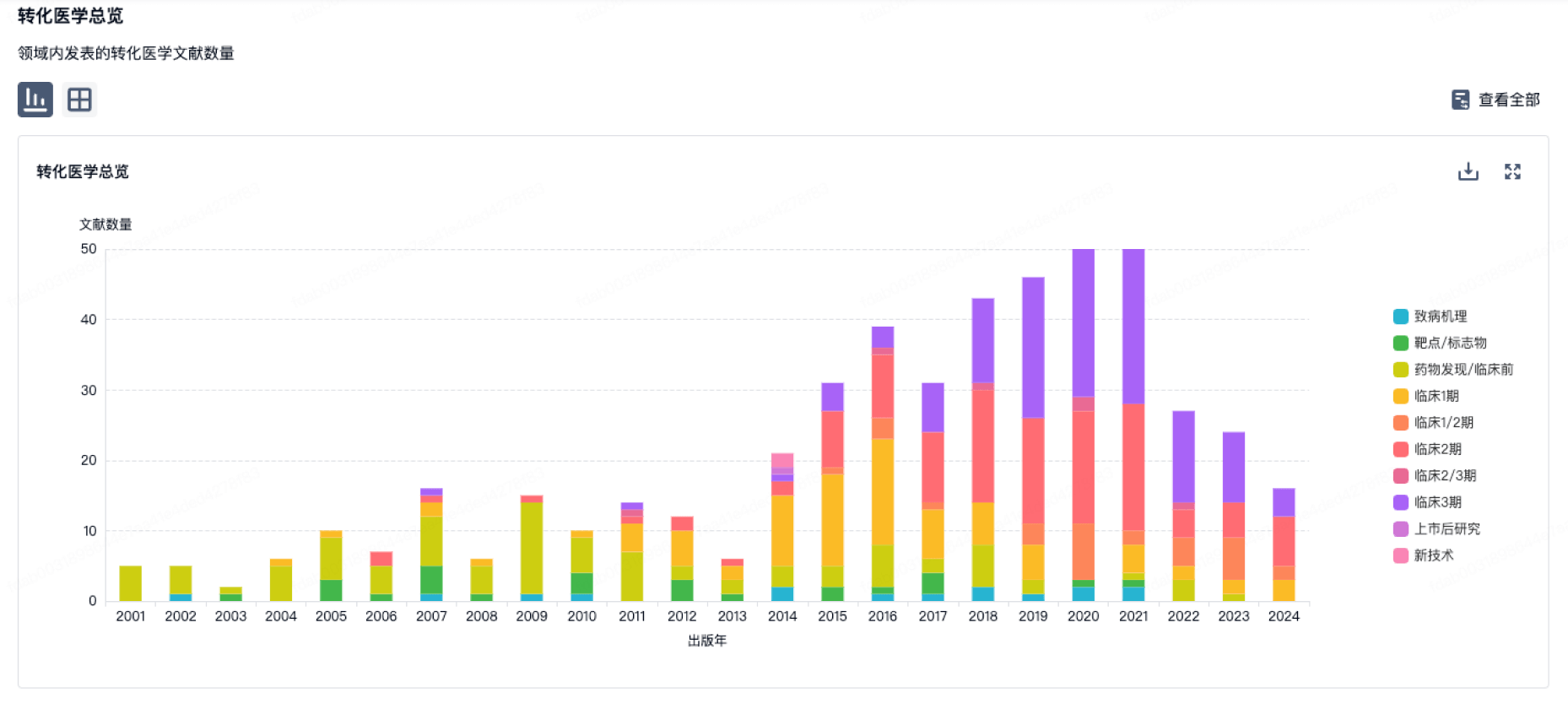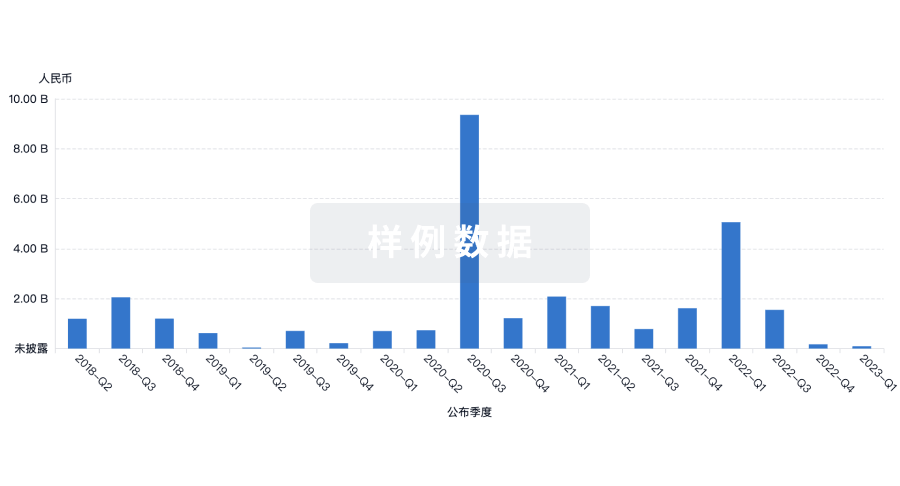预约演示
更新于:2025-05-07
Farmitalia Carlo Erba
私营公司
私营公司
更新于:2025-05-07
概览
关联
2
项与 Farmitalia Carlo Erba 相关的药物作用机制 IGF-1R拮抗剂 [+3] |
在研机构- |
原研机构 |
在研适应症- |
最高研发阶段终止 |
首次获批国家/地区- |
首次获批日期- |
作用机制 FGFRs拮抗剂 [+3] |
在研机构- |
在研适应症- |
最高研发阶段无进展 |
首次获批国家/地区- |
首次获批日期- |
1
项与 Farmitalia Carlo Erba 相关的临床试验ISRCTN72126158
A Double Blind, Randomised, Placebo Controlled Study of Farlutal in the Treatment of Weight Loss in Patients Undergoing Radiotherapy for Head and Neck Cancer
开始日期2000-08-19 |
申办/合作机构 |
100 项与 Farmitalia Carlo Erba 相关的临床结果
登录后查看更多信息
0 项与 Farmitalia Carlo Erba 相关的专利(医药)
登录后查看更多信息
214
项与 Farmitalia Carlo Erba 相关的文献(医药)1996-01-01·Annals of Internal Medicine1区 · 医学
United Kingdom Prospective Diabetes Study 17: A 9-Year Update of a Randomized, Controlled Trial on the Effect of Improved Metabolic Control on Complications in Non-Insulin-dependent Diabetes Mellitus
1区 · 医学
Article
作者: Holman, Rury ; Turner, Robert ; Cull, Carole
1995-01-01·Drug Development and Industrial Pharmacy
Use of Colloidal Silica as a Separating Agent in Film Forming Processes Performed with Aqueous Dispersion of Acrylic Resins
作者: Fabiani, F. ; Gazzaniga, A. ; Vecchio, C.
1994-06-01·Organic Preparations and Procedures International
EFFICIENT REGIOSELECTIVE ALKYLATION OF 2-CARBOXAMIDOPIPERAZINE. APPLICATION TO THE SYNTHESIS OF THE NMDA COMPETITIVE ANTAGONIST (±)-CPP
作者: Varasi, M. ; Pevarello, P. ; Scappi, G.
4
项与 Farmitalia Carlo Erba 相关的新闻(医药)2025-04-03
·汇聚南药
2025年3月,国家知识产权局对中美华东吲哚布芬晶型D专利(ZL202211596913.5)的无效宣告请求案作出维持专利权有效的无效决定。这一结论虽为中美华东保留了法律意义上的“独占权”,却因保护范围的严格收窄引发行业对专利实质价值的争议。事实上,针对吲哚布芬晶型专利,已有多家仿制药企业发起无效挑战,但均未获成功。这场专利风暴的蝴蝶效应早在半年前就已显现。2024年9月,中美华东率先对浙江美迪深生物发起专利诉讼,直接导致后者被取消公立医院采购资格。图源:上海阳光采购网随后争议如多米诺骨牌般扩散:2025年2月,湖南九典、浙江同伍等企业的吲哚布芬片接连遭遇停售令,仿制药市场版图在专利铁幕下支离破碎。图源:上海阳光采购网截至当前,国内布局该药物的20余家药企中,已有11家通过一致性评价的仿制药企卷入专利纠纷漩涡。更值得思考的是,国家知识产权局的无效决定虽在法律程序上为侵权纠纷保护范围的争议画下句号。但因技术认定层面的争议性,在医药界激发出更为尖锐的讨论。01独裁?中美华东死咬“吲哚布芬”专利吲哚布芬片由意大利Farmitalia Carlo Erba公司70年代研发并于1971年提交专利申请,1984年意大利率先上市。作为非甾体抗血小板药,通过抑制COX-1减少血栓素,抗栓效果为阿司匹林2-5倍且胃肠风险更低,现为动脉硬化性心脑血管病及静脉血栓防治中不耐受阿司匹林者的替代首选。图源:药源网这样一款获批多年的老药屡陷专利纷争,究其根源,背后推手或许是巨额的市场利润。经过搜索可知,吲哚布芬的原研化合物专利(DE2154525A1,1971年)和适应症专利(BE818033A1,1974年)均已过期。原研专利过期后,国内由华东医药独家仿制垄断。自2017年纳入医保体系以来,短短数年内销售额激增数倍,迅速蜕变为10亿量级的市场黑马。中美华东为巩固其年销超10亿元的大单品——吲哚布芬的市场主导地位,开始布局“专利矩阵”。2016年申请晶型A和B (申请号“201610663448.0”),2020年申请晶型X/D (ZL202011484428.X,保护期限至2040年12月)。尽管原研药未公开晶型数据,但中美华东基于原研产品实际晶型构建专利壁垒,通过制备方法及衍生技术限制其他仿制药准入市场门槛。02存疑,超长待机专利的绝对占有是否合理1.“特定晶型”VS“泛化保护”在吲哚布芬晶型专利案中,业内人士的异议主要围绕着吲哚布芬专利中晶型的保护范围。关于权利要求中“晶型X”和“晶型D”的具体含义存在不同理解。如最新决定所认定的,其应限定为说明书中明确记载的包括附图7在内的特定晶型D;另一种观点则认为其可能涵盖更广泛的保护范围,只需要具有权利要求所限定的5个特征峰或16个特征峰的特定晶型。图7来源:国家知识产权局根据专利法第64条第1款的规定,“专利权的保护范围以其权利要求的内容为准,说明书和附图可以用于解释权利要求的内容”。对于晶型发明而言,实践中通常有两种表达方式:一种是采用部分特征峰进行限定,另一种是采用X-射线粉末衍射谱图(XRPD)全谱(如同人的指纹一样)限定。一般情况下,若权利要求采用部分特征峰对要求保护的产品进行限定,通常表明专利权人主观上意欲获得一个相对较宽的保护范围,而不是局限于实施例实际制备得到的具体晶型产品,即与使用具体XRPD全图限定的权利要求的保护范围是不同的。如果本案按照部分特征峰而不考虑晶型D的特殊代号来确定其保护范围,则将面临该专利相对于现有技术不具有新颖性的明显缺陷。无效决定也对此进行了说明,“如上图所示,样品1-3的XRPD谱图基本相同,…但其与本专利晶型D谱图则存在较大差异,因此,尽管证据7结论显示‘本专利与样品1-3的特征衍射角2θ均显示重叠’,但基于前述本领域公认的判断原则,现有谱图对比并不足以使得本领域技术人员确认二者是相同的晶体。”来源:国家知识产权局本案和其他晶型不同之处在于,权利要求的保护主题为某一代号表示的晶型,无效决定应该是基于“自定义”的逻辑认为,结合说明书的内容,该代号被赋予了特定的含义,使得本领域技术人员认为该权利要求保护的仅为说明书中公开的某一具体晶型,则无论权利要求采用部分特征峰限定还是XRPD全图限定,其保护范围应当均指向说明书中公开的该具体晶型,其具有说明书中的性质/参数。具体而言,专利1(晶型X)必须与说明书中的“身份证”完全一致,包括XRPD、热重分析数据(TGA)等全套参数,差一个峰均不成立;专利2(晶型D)的权利要求虽列出5个或16个特征峰,但实质上均来自于权利要求3限定的XRPD。这应当理解为采用不同的参数特征对同一晶型,即晶型D进行表征,该晶型具有说明书中包括XRPD、TGA、DSC等的全部相关描述, 其他仿制药企若想规避侵权,需彻底绕开说明书记载的该晶型的全部特征。针对“晶型X和晶型D是否覆盖相似结构”的争议,合议组彻底消除了模糊地带,明确“专利只管说明书里长啥样”——相当于把保护范围圈定到极其精确的细节,例如包括衍射峰位置、衍射峰数量以及衍射峰强度等。其他仿制药企只要有相应的晶型参数不一样(例如数量不同,峰位置不同或者峰强度不同),理论上即可跳出专利“框定”的安全区。中美华东看似赢了官司,实则手握“玻璃盾牌”:法律上虽高举“独家”招牌,但对手通过微调结晶工艺生成参数差异化的新晶型,便能轻松绕过专利封锁。这一结果折射出单一晶型专利的脆弱性——管得住照抄,却拦不住魔改。未来,晶型专利的博弈重心将转向技术壁垒的“硬度”与仿制规避的“成本”。中美华东虽然以制备方法、组合物等外围专利“补刀”,而其他仿制药企则需在参数调整的钢丝上精准平衡技术可行性与侵权风险。真正的胜负手,早已从一纸裁决转向了专利布局的纵深战场。2.专利丛林成垄断护身符从反垄断规则视角观察,中美华东的市场策略呈现出值得警惕的商业博弈特征。根据《反垄断法》第24条规定,经营者市场份额超过50%即可推定具有市场支配地位。而该公司2023年实现100%市场占有率的事实,已初步构成反垄断法意义上的支配地位认定要件。值得关注的是,该企业在专利维权的技术面纱下,可能潜藏着滥用市场地位的商业策略。即便专利本身合法有效,但若企业利用专利持续打压竞争对手、过度限制市场准入,这种经营策略本身就可能触碰反垄断红线。所以当拥有绝对市场支配地位的主体,基于限定性晶型专利(X/D型)对全行业仿制药企发起系统性诉讼——特别是针对技术特征存在明显差异的非侵权产品时,这种全面狙击行为实质上形成了市场封锁效应。数据显示,2024年通过评价的11家仿制药企中,超过半数因诉讼程序被迫暂停挂网,形成"诉讼未决,市场先封"的竞争压制格局。而中美华东的专利诉讼的背后或许也有另外一层深意。不管最终结果如何,中美华东率先发起诉讼都是利大于弊。由于专利无效宣告程序与侵权诉讼之间存在程序性延迟,整个法律攻防往往陷入漫长消耗战。对于年销售额逾十亿元的核心产品而言,能拖延一天竞品进入市场,就意味着多赚一天的钱。此外,根据《反垄断法》第22条,若证据显示诉讼行为超出正当维权范畴,构成无差别打击竞争对手的手段,则可能触发"滥用市场支配地位"的法律风险。最终判定需回归技术实质:若仿制药企产品确未落入专利保护范围,而权利人仍以诉讼手段进行市场压制,则该行为可能面临反垄断规制。03结语专利保护为企业搭建技术护城河的同时,也要守住市场公平竞争的底线。当中美华东借晶型专利延长独占红利,行业更应思考:如何在技术迭代与仿制药可及性间建立平衡,让专利真正服务于创新活力,而非成为产业升级的隐形枷锁。专利丛林是否会被技术击穿?反垄断重锤是否会击碎壁垒?十亿市场的天平摇摆间,下一枚多米诺骨牌倒向何方?答案藏于衍射数据与判决文书的无声角力中,我们将持续追踪。 喜欢我们文章的朋友点个“在看”和“赞”吧,不然微信推送规则改变,有可能每天都会错过我们哦~免责声明“汇聚南药”公众号所转载文章来源于其他公众号平台,主要目的在于分享行业相关知识,传递当前最新资讯。图片、文章版权均属于原作者所有,如有侵权,请在留言栏及时告知,我们会在24小时内删除相关信息。信息来源:药闻天下往期推荐本平台不对转载文章的观点负责,文章所包含内容的准确性、可靠性或完整性提供任何明示暗示的保证。
专利侵权专利无效专利到期一致性评价
2025-02-26
·药筛
不是原研,却有超长专利保护期,年销10多亿元。其它多个仿制药上市,但不能合法销售。
这个品种就是吲哚布芬片。
2月24日,上海阳光医药采购网公告,因专利纠纷,暂停湖南九典和浙江同伍的吲哚布芬片挂网采购资格。
吲哚布芬片是一种COX-1抑制剂类抗血小板药,临床用于预防和治疗动脉粥样硬化性心血管等疾病,可作为阿司匹林不耐受的替代药物。
产品最早是意大利的Farmitalia Carlo Erba公司(后被辉瑞收购)于1970年代开发,1984年首次在意大利获批上市。
国内市场,原研没有进口,现在也没有原研相关专利。
齐鲁和华东医药很早就仿制上市,但齐鲁的批文已经过期,只有华东医药独家在售,2023年医院市场销售已超过14亿元。
这样的品种,必然也是仿制热门,目前已有十多个其他仿制药厂家获批,还有一大批上市申请处在审评。
但是,由于华东医药申请了相关专利,其它仿制企业,无法合法销售。
据国家知识产权局官网信息,中美华东制药已登记的相关专利中,有个晶型专利有效期至2040年。
如果这个专利,能阻止其他仿制药上市销售,华东的还能吃5年独食,岂不美哉。
不是原研,却能有如此超长保护期。
其它仿制药企业,会一直坐等专利到期吗?
相关阅读:
强行专利无效,抢首仿
专利未到,首仿先行
这个降脂药,已有3个企业报临床了
用摩熵药筛小程序,快速查询产品申报进展!
专利到期并购专利无效带量采购
2025-02-25
药械追踪
No.1 / 辉瑞血友病疗法马塔西单抗落地乐城先行区
2025年2月14日,辉瑞血友病创新疗法HYMPAVZI(马塔西单抗/Marstacimab)正式落地海南博鳌乐城先行区。
马塔西单抗是由辉瑞公司研发的一种血友病新型疗法,是一种靶向组织因子途径抑制物(TFPI)K2结构域的单克隆抗体,属于血友病再平衡疗法。
目前马塔西单抗已在美国和欧盟获批用于治疗血友病A及血友病B。马塔西单抗是首个通过预充式注射笔皮下注射固定剂量给药的创新疗法,只需每周一次。此前,该药已在中国进入罕见病“关爱计划”,并作为1类新药向国家药监局提交上市申请。
->点击文末阅读原文,解锁完整双语新闻
No.2 / 辉瑞与Summit达成依沃西单抗与ADCs联合治疗应用
2025年2月24日,康方生物依沃西国际市场开发合作伙伴Summit Therapeutics(Nasdaq:SMMT)宣布,已与辉瑞(NYSE:PFE)达成临床试验合作,共同推进康方生物自主研发的PD-1/VEGF双抗依沃西与辉瑞多款抗体偶联药物(ADCs)在多种实体瘤中的联合治疗应用。
此次合作的目标是深入挖掘依沃西联合辉瑞多款vedotin系列ADCs药物联合疗法在多种实体瘤中的巨大协调潜力,加速推进可能重塑治疗格局的创新联合疗法,为那些面临重大未满足医疗需求的患者带来更优的治疗选择。根据协议条款,辉瑞将全面负责本次合作的系列临床试验的开展,Summit将提供依沃西单抗用于该系列临床试验;双方共同监督临床研究的进行;同时,双方将各自保留其产品的相关权利。目前依沃西单抗在全球开展临床试验药物均由康方生物生产供应。
依沃西单抗是康方生物独立开发的一款全球首创(first-in-class)双特异性抗体,可同时阻断PD-1和VEGF通路,发挥免疫效应和抗血管生成效应。2022年12月,康方生物与Summit达成协议,授予后者依沃西单抗于美国、加拿大、欧洲和日本的开发和商业化独家许可,总交易金额最高可达50亿美元。2024年6月,双方扩大依沃西单抗的合作范围,Summit将新增获得依沃西在中美、南美、中东和非洲等相关市场的开发及商业化独家权益,Summit还将继续负责包括新增许可市场在内的所有许可地区的临床开发、产品注册及商业化,及其所有相关费用。
->点击文末阅读原文,解锁完整双语新闻
No.3 / 山德士在美推出乌司奴单抗生物类似药Pyzchiva
2025年2月25日,山德士(SIX:SDZ)宣布,其韩国合作伙伴Samsung Bioepis开发的乌司奴单抗生物类似药Pyzchiva已在美国获批并将全面商业化上市。
Pyzchiva由Samsung Bioepis开发,山德士于2023年9月与Samsung Bioepis签订协议,负责Pyzchiva在美国、加拿大、欧洲经济区、瑞士、英国和巴西的商业化推广。Pyzchiva已获得美国食品药品监督管理局(FDA)批准,用于治疗慢性炎症性疾病,覆盖原研乌司奴单抗(强生喜达诺)已获批的全部适应证。
->点击文末阅读原文,解锁完整双语新闻
No.4 / 美敦力自适应深部脑刺激系统在美获批,治疗帕金森病
2025年2月24日,美敦力(NYSE:MDT)宣布,BrainSense自适应脑深部刺激(aDBS)和BrainSense电极标识符(EI)已获美国食品药品监督管理局(FDA)批准,适用于治疗帕金森病。
DBS通过微创手术植入神经刺激器,向大脑特定区域发送电信号,可用于帕金森病等神经系统疾病的治疗。BrainSense系统采用独有的自适应技术,对DBS神经刺激器进行了升级,能够检测、捕获和分类不同的大脑信号,实现根据患者的实时大脑活动定制疗法、自动调整,为患者提供更精确、更个性化的治疗。
->点击文末阅读原文,解锁完整双语新闻
企业动态
No.1 / 迪哲医药2024年报:营收超3.6亿元,同比增长294.79%
2025年2月25日,迪哲(江苏)医药股份有限公司(迪哲医药,688192.SH)发布了2024年度业绩快报。公司全年营业收入36,039.45万元,同比增长294.79%;归母净亏损85,677.15万元,较上年度缩减25,094.18万元。
2024年是迪哲医药实现产品销售收入的第一个完整会计年度。公司第二款核心产品高瑞哲(戈利昔替尼)于2024年6月通过优先审评获得国家药监局(NMPA)批准上市,成为全球首个且唯一作用于JAK/STAT通路的外周T细胞淋巴瘤(PTCL)新机制治疗药物。高瑞哲与公司首款核心产品舒沃哲(舒沃替尼)均在2024年成功纳入新版医保目录,有望进一步提高药物在患者中的可负担性和可及性。此外,舒沃哲在美国提交的新药上市申请已于2025年1月获FDA受理并予以优先审评,用于二/后线治疗表皮生长因子受体(EGFR)20 号外显子插入突变(exon20ins)的晚期非小细胞肺癌(NSCLC)。
->点击文末阅读原文,解锁完整双语新闻
No.2 / 九典制药、同伍生物吲哚布芬采购资格被暂停
2025年2月21日,上海招采办发布通知,根据杭州市知识产权局《专利侵权纠纷案件行政裁决书》(浙杭知法裁字[2024]9号),暂停湖南九典制药股份有限公司和浙江同伍生物医药有限公司吲哚布芬片的采购资格。
吲哚布芬由意大利公司Farmfalia Carlo Erba(后被辉瑞收购)原研,是一种异吲哚啉基苯基丁酸衍生物,为一种血小板聚集的抑制剂,可用于动脉硬化引起的缺血性心血管病变、缺血性脑血管病变、静脉血栓形成,也可用于血液透析时预防血栓形成。原研在国内未上市,据中国上市药品专利信息登记平台,国内只有华东医药登记了名为“一种吲哚布芬晶型X和晶型D及其制备方法”专利(ZL 202011484428.X),有效期至2040年12月16日。鉴于晶型专利并不是专利链接的范围,因此国内其他仿制药均申报的1类专利声明。
据业内消息,就吲哚布芬片专利侵权事件,中美华东制药与多家公司有纠纷。但华东医药作为仿制药厂家,是否属于专利登记规定,以及晶型结构专利也不是专利链接的受理范围,都在业内引起热议。
->点击文末阅读原文,解锁完整双语新闻
全球医疗情报领导者
解锁隐藏在数据中的商业潜力
关于 G B I
”
自从2002年成立以来,GBI始终以技术为驱动,为药企、器械及行业相关服务商提供贯穿生命周期的全球药品市场竞争数据、全球行业资讯、HCPs洞察、全国医疗器械数据等商业信息与洞察,助力企业在进行战略布局和决策时,脱颖而出。历经20余年的深耕细作GBI已成为95%以上跨国药企、国内头部药企、咨询与投资机构等医疗圈灯塔用户值得信赖的长期合作伙伴。
联系我们
投稿 | 发稿 | 媒体合作
▶ zhangxinyue13@baidu.com
数据库 | 咨询服务 | 资讯追踪
▶ 点击左下“阅读原文”完成表单填写
点击阅读原文,解锁完整双语新闻
抗体药物偶联物生物类似药优先审批上市批准
100 项与 Farmitalia Carlo Erba 相关的药物交易
登录后查看更多信息
100 项与 Farmitalia Carlo Erba 相关的转化医学
登录后查看更多信息
组织架构
使用我们的机构树数据加速您的研究。
登录
或

管线布局
2025年11月04日管线快照
管线布局中药物为当前组织机构及其子机构作为药物机构进行统计,早期临床1期并入临床1期,临床1/2期并入临床2期,临床2/3期并入临床3期
其他
2
登录后查看更多信息
当前项目
| 药物(靶点) | 适应症 | 全球最高研发状态 |
|---|---|---|
FCE-27164 ( FGFRs x IL-1β x PDGFB x c-Met ) | 实体瘤 更多 | 无进展 |
Suradista ( IGF-1R x IL-1β x PDGFB x c-Met ) | 实体瘤 更多 | 无进展 |
登录后查看更多信息
药物交易
使用我们的药物交易数据加速您的研究。
登录
或

转化医学
使用我们的转化医学数据加速您的研究。
登录
或

营收
使用 Synapse 探索超过 36 万个组织的财务状况。
登录
或

科研基金(NIH)
访问超过 200 万项资助和基金信息,以提升您的研究之旅。
登录
或

投资
深入了解从初创企业到成熟企业的最新公司投资动态。
登录
或

融资
发掘融资趋势以验证和推进您的投资机会。
登录
或

生物医药百科问答
全新生物医药AI Agent 覆盖科研全链路,让突破性发现快人一步
立即开始免费试用!
智慧芽新药情报库是智慧芽专为生命科学人士构建的基于AI的创新药情报平台,助您全方位提升您的研发与决策效率。
立即开始数据试用!
智慧芽新药库数据也通过智慧芽数据服务平台,以API或者数据包形式对外开放,助您更加充分利用智慧芽新药情报信息。
生物序列数据库
生物药研发创新
免费使用
化学结构数据库
小分子化药研发创新
免费使用
